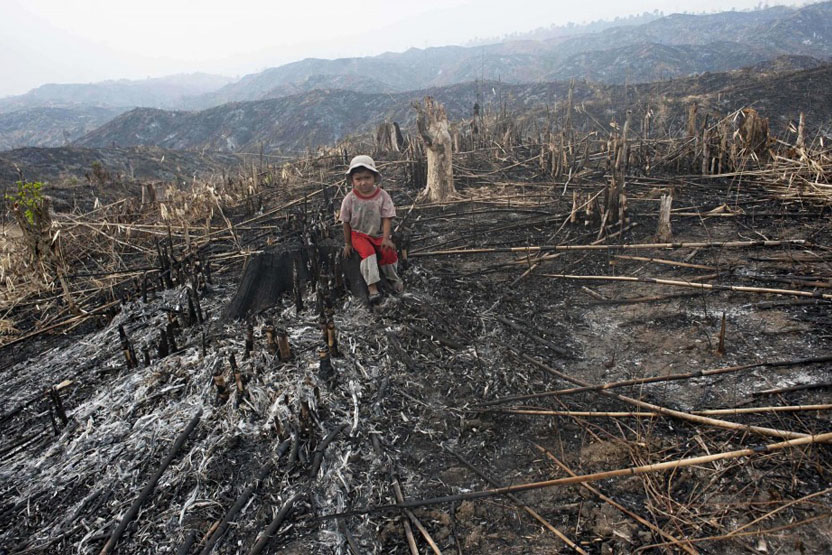
With the radical transformation of the planet’s climate, the rapid spread of infectious diseases linked to environmental crises has become more alarming. Deforestation, pollution, extreme heat, and violent weather events are increasingly tied to the emergence of zoonotic diseases and vector-borne viruses, now a major public health concern.
In 2018, researchers from Poland and France published a study highlighting the possibility that COVID-19 infections could emerge as a result of deforestation, particularly in Southeast Asia.
The researchers started from the hypothesis that bat populations carrying the virus had settled closer to human dwellings after losing their natural forest habitats, finding shelter in homes and barns where their lifestyles overlapped with human environments.
This proximity increased the risk of disease transmission from bats to humans, confirming the zoonotic consequences of environmental degradation driven by human activities.
Zoonotic spillovers—also known as cross-species transmissions—are defined as the transfer of pathogens from animals, usually vertebrates, to humans. This pathway accounts for nearly 60 percent of emerging infectious diseases.
One major example is the emergence of HIV, originating from simian immunodeficiency viruses in African primates, which sparked the global AIDS pandemic.
Another case is Ebola, which is thought to have spread from fruit bats to humans, leading to devastating outbreaks that peaked in West Africa. Misuse of land and forests—particularly human expansion into forested areas—therefore carries the inherent danger of exposing people to pathogens and the animals that host them.
The risks of environmental change
Deforestation also alters the abundance and distribution of animals and vectors that carry pathogens. Pathogens can spread more easily to humans via vectors—typically arthropods such as mosquitoes, ticks, flies, and fleas.
Examples of vector-borne diseases include dengue, malaria, Zika, and chikungunya. Like direct zoonotic spillovers, these diseases are influenced by deforestation.
A study assessing the impact of deforestation on mosquito populations in 12 countries across five continents found that more than half (52.9%) of the 87 mosquito species analyzed actually thrived in deforested areas, including those known to transmit pathogens to humans.
Deforestation leads to the change of habitats and the spread of vectors near human settlements
Artificial water bodies created by humans, as well as livestock serving as alternative hosts, are also key factors in boosting vector populations.
Another study revealed a strong link between shrinking forest areas—particularly due to palm oil expansion—and the global increase in zoonotic and vector-borne disease outbreaks between 1990 and 2016. Infectious diseases, the study emphasized, are an environmental side effect of deforestation.
Biodiversity loss, an inevitable consequence of deforestation, is another concern. Reduced species diversity can increase the transmission of vector-borne diseases in affected areas, such as Lyme disease and West Nile virus in the United States.
An interactive map developed by researchers at the University of Hawai‘i at Mānoa illustrates how different climate risks affect the spread of human pathogens. It provides clear evidence that climate change influences the distribution of infectious diseases.
The key factor driving climate-linked disease spread is the availability and infectious capacity of vectors. Since vectors are cold-blooded, warming temperatures are expected to boost their abundance, survival, feeding activity, and the rate at which pathogens develop inside them.
As global warming accelerates, especially with rising land-surface temperatures, pathogens will shift or expand into new geographic regions. For example, malaria has been recorded at higher altitudes in Ethiopia and Colombia during warmer years.
Other studies have shown how temperature, rainfall, humidity, and wind affect mosquito populations that can transmit West Nile virus, with outbreaks linked to specific weather events across Europe, Eurasia, and the Americas.
In 2023, the Aedes albopictus mosquito—responsible for transmitting dengue and chikungunya—was reported in 13 EU countries, up from just 8 in 2013.
Climate-related diseases
A separate study predicted that dengue fever will spread into regions that are currently low-risk or free of the disease. By 2080, an additional 2.25 billion people could be at risk of contracting dengue compared to 2015 levels.
However, the relationship between climate change and vector-borne diseases is complex and multi-factorial, meaning no single variable can accurately predict outbreaks. Human-vector-environment interactions must also be considered.
Beyond vector-borne diseases, extreme climate events can also trigger zoonotic outbreaks. Sharp seasonal shifts in temperature or rainfall, for example, may temporarily increase food supplies for rodents, causing population explosions and greater disease risks.
Other extreme weather events linked to climate change—such as hurricanes, storms, and floods—facilitate the spread of waterborne diseases. Flooding can mobilize pathogens in the environment and compromise sewage systems, creating serious public health risks.
Rising sea temperatures further enable the growth and spread of harmful bacteria. Of particular concern is Vibrio cholerae, the bacterium responsible for cholera epidemics, which thrives in warmer waters.
The study concludes that understanding the wide range of environmental factors driving infectious diseases is crucial for ensuring future health security. Addressing this growing threat requires coordinated global action—especially at the political and institutional levels.



Comment
Reply